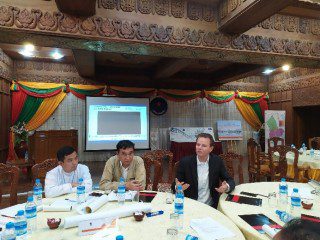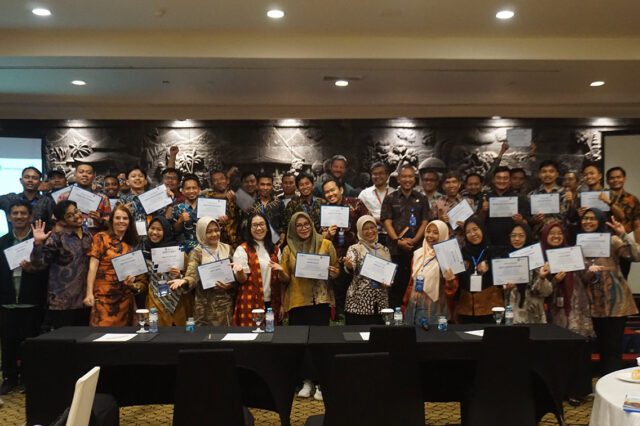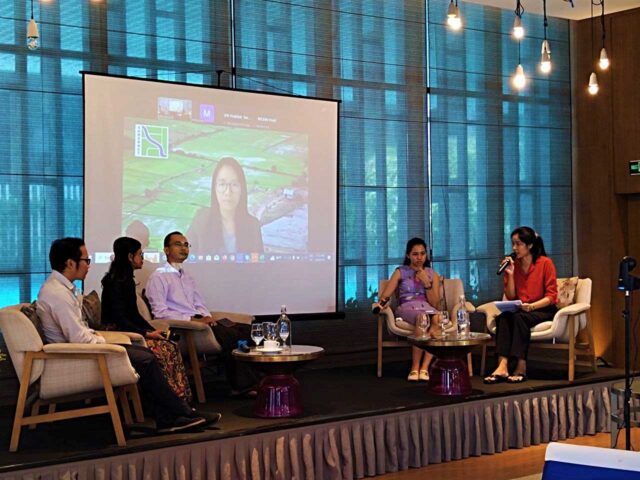PIB UWLY Workshops – Consortium Members and local Stakeholders meet in Yangon
On 23rd of July, the PIB UWLY consortium has come together again to host a high-level workshop at Yangon Region Government office which aims to discuss and obtain solid next steps and pragmatic solutions for the water challenges of Yangon region.
Two seperate workshops were hosted:
- Multi-modal Transport System Workshop
- Water Supply Policy Yangon in which stakeholders from Myanmar Port Authority (MPA), Directorate of Water Resources and Improvement of River Systems (DWIR), Inland Water Transport (IWT), Department of Marine Administration (DMA), Yangon City Development Committee (YCDC) and Parliament Members (PM), Myanmar Engineering Council (MEC) and Myanmar Maritime University (MMU) interactively participated. Read more about this workshop here.
Workshop: Yangon as Resilient Logistic Center of a Multimodal Transport System
Developing Technical Guidelines Workshop (Vessel Collision Risk Perspective)
Yangon port is major gateway for international maritime trade of the country and growing over time so is the number of vessels running through the river. In that case, technical guidelines are crucial in either developing countries or developed countries because these will guide the developments of important infrastructure such as Ports and Waterways to mitigate risks of vessel safety, over-investment, quality issues, etc. There are several steps to be taken in developing of these guidelines which requires requirements to be defined by different stakeholders in the industry such as port authorities, port operators, shipping lines, regional governments, institutes, technical consultants, etc.
This part of the workshop is to present one of the main requirements in developing of technical guidelines for ports developments along a river which is vessel collision risk due to congestion on the river based on different (growing) scenarios and to discuss with key stakeholders and collect input data for simulation related to navigation and vessel traffic on the Yangon River. Key stakeholders involved in the workshop actively. Key stakeholders include Myanma Port Authority (MPA), DWIR, IWT, Myanmar Maritime University (MMU) and Myanmar Engineering Council (MEC). Mr. René van Duijn, logistics and transportation expert from Royal HaskoningDHV presented about a traffic and logistics simulation software called FlexSim that models, simulates, predicts, and visualizes systems in logistics and other industries.
Then he led the interactive workshop discussing stakeholder’s expectation from simulation, project goals and boundaries, major points of interest in the system, required information and model set up and key performance indicators. He also explained about the model set up, capability, benefits and limitation of software and enquired about expectation from the simulation from each stakeholder. After better understanding of the simulation, the discussion went better with energetic round table discussions. Mr. Rene conversed expected Key Performance Indicators (KPIs) from each stakeholder, especially MPA. Expected KPIs include waiting time at berths and anchorage areas, turnaround time for each vessel, queue sizes and times at bottlenecks and anchorages. MPA participated in discussions mainly for navigation components on Yangon River such as anchorage areas, historical vessel traffic, future vessel traffic forecast and other rules and regulations of navigation and ship manoeuvring on the Yangon River.
As a result, UWLY consortium obtain important insights regarding to existing and future port developments along the Yangon River which will generate more vessels and thus more congestion potentially. Next step of the consortium is to build the simulation model based on the workshop and run with different vessel traffic growth scenario. Next workshop will present about the results of simulation. Based on KPIs, the simulation will identify the traffic congestion risks due to vessel traffic growth with different port development scenario.

Dredging Decision Support System – Owner’s Perspective
Dredging is always a subject required to be planned and executed carefully at Ports all around the world. As port owners, it is important to understand how to manage the dredging campaigns. The objective of the workshop is to share the knowledge of managing the dredging campaign from the port owner’s perspective.
Yangon River is unique with characteristics of high tidal range, high two directional river flow and high sedimentation rates at inner sand bar and outer sand bar which challenge the port operators and shipping lines. UWLY consortium presented about Tender Process from Employer’s perspective which was requested by Chief Minister to be included in this workshop.
During the workshop, the extensive knowledge about the different types of dredging contracts and its pros and cons, preliminary studies before the tender and tender process (categories of Dredger, specification, budget allocation, etc) were shared by Mr. Martin Reichwein, South East Asia regional business development director from Van Oord (VODMC).
After discussion with all participants, it is concluded that Yangon river has many challenges for the navigation as well as dredging. These challenges include the issue of design relating to dredging such as rapid sedimentation at inner bar, slope stability due to dredging, river bank erosion/protection, naturally high in current velocity, high level of tidal range, determination of disposal area for dredged materials, selection of dredging equipment for shallow river bed ranging from 2.0 meters to 4.8 meters depth. There is another issue relating to dredging is that the debris/sunken objects on the river bed. These objects may obstruct the dredging activity and so the scope of cleaning of those objects on river bed shall be incorporated in tender document as required.
The overall comments about dredging in Yangon river is that to form the dredging decision support system should be considered not only for maintenance dredging but also for capital dredging. Detail surveying to investigate the characteristic of Yangon river with the effect of tide thoroughly & necessary modelling shall be done before dredging. Preliminary investigation shall include the cause of high sedimentation rate in the river to minimise excessive sedimentation if possible.
Tender preparation should allow the advanced dredging technologies. For instance, Water Injection Dredger (WID) for Yangon river dredging can be an alternative to traditional dredging technologies. WID is in line with Building with Nature concept and it could be considered as one of the suitable options for dredging in Yangon river for which significant budget has been spending annually for maintenance dredging. Consortium proposed WID dredging as it has potential to lower the cost of mobilisation & demobilisation charges and it can be deployed at site longer than traditional dredgers.

Integrated Multi Modal Transport Cost Environmental Model (IMMTCE)
In the matter of logistics, Mr Harrie Laboyrie from CDR international, introduced the Integrated Multi Modal Transport Cost Environmental Model (IMMTCE) which can determine transport cost and environmental benefits per Origin-Destination for different commodities and transport modes and the results of the model is permitted to determine the net economic savings in transportation cost as a function of Least Available Depth (LAD). IMMTCE holds these value propositions:
- Integration of multi modal transport modes: inland waterways, ports, road, railway, aviation, pipe lines;
- Integrated cost calculation for various development scenarios for Government Authorities;
- Trip and port planning for fleet operators and port authorities;
- Business model via an application on smart phone, tablet, computer via a subscription fee;
- True integration of physical infrastructure and transport economics;
- Moving the water business digitally forward in a sustainable manner;
- Contribution to the Sustainable Development Goals (SDG’);
- Proven Technology in a new area
PIB UWLY workshop related news articles:
- https://www.facebook.com/ChiefMinisterOffice.YangonRegionGovernment/posts/2856215737785997
- https://www.myanmarwaterportal.com/pages/urbanwaterlogisticsyangon.html
- https://thewateragency.com/services/education/port-of-the-future-serious-game/
- https://www.myanmarwaterportal.com/news/1185-prof-tiedo-vellinga-in-yangon.html






